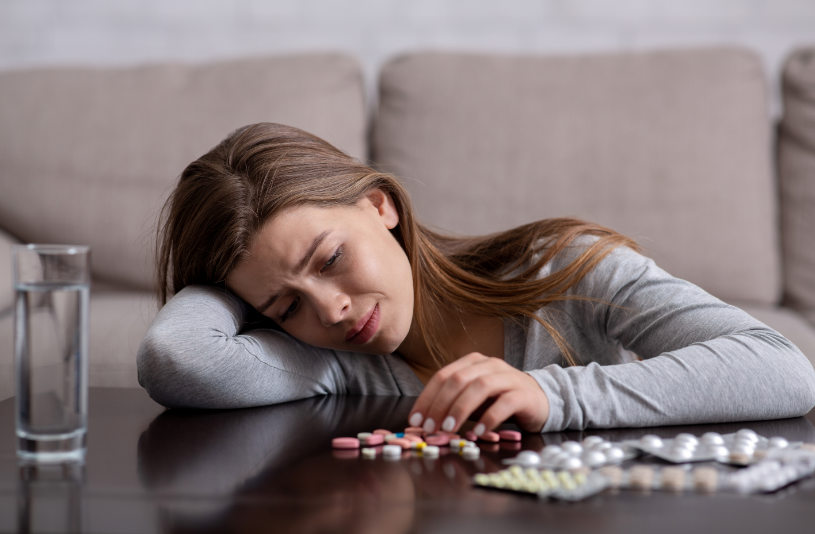Citalopram (brand name Celexa) is under the drug class SSRIs (selective serotonin reuptake inhibitors) and its main use is for the treatment of mental health conditions including depression and obsessive-compulsive disorder. Additionally, Celexa drug is also useful in treating panic disorder and social phobia. In 2003, around 56,000 SSRI overdoses occurred in the United States and within the group of SSRIs, Citalopram had the highest fatality case rate caused by drug overdose.
Table Of Contents:
Citalopram can vastly improve the lives of patients when it is taken properly. However, during unintentional overdose or abuse of the drug, significant risks such as seizures may occur. Because of this, there is a need for users to understand Celexa overdose symptoms and what to do if they notice them. In this article, information about Citalopram overdose symptoms and causes, the dangers and risk factors for overdose, medical treatment, and management of overdose will be provided.
SSRIs like Celexa rarely resulted in toxicity or death on their own. Instead, Celexa overdose death is most common when other substances are being used or abused at the same time.
Can You Overdose On Celexa?
If someone is wondering, can you overdose on Celexa? The answer is yes. Taking too much of the drug can result in significant adverse side effects, up to and including death. Additionally, someone who is overdosed on Citalopram unintentionally (when a patient has mistaken the drug for another or when a patient is unaware that he or she has already taken the drug) may also experience adverse side effects. According to a study, accidental ingestion of Citalopram may also happen in children, and symptoms such as convulsions and other heart problems may be observed. In the same study, if a person has ingested a dose of 600 mg or lower, only mild symptoms will be seen.
On the other hand, ingestion of 600 mg or more will cause heart or ECG abnormalities. However, everyone is different and this also means that one person may experience different symptoms from another. Some may experience mild symptoms while others may experience severe ones. That is why it is important to always follow the doctor’s direction.
Overdosing on Citalopram alone is rare, and death from Celexa overdose is even less common. The Celexa max dose in therapeutic settings for patients 60 years old and older is 20 mg per day, with most patients not being allowed to go higher than 40 mg per day. If a patient is taking other medications or abusing substances while taking Celexa, drug interactions may increase the chances of toxicity to occur even if the patient is only taking a low dose of Celexa.
Celexa Overdose Symptoms
Celexa overdose may be accidental or intentional and because many overdoses are accidental, patients and their loved ones need to know what symptoms should be observed. Being able to spot or identify these symptoms will help a patient avoid the worst possible circumstances. The symptoms in this section happen due to several reasons including abuse of the drug and when drug interactions occur.
Common Symptoms Include:
| Mental and Nervous System |
|
| Heart and Blood |
|
| Eyes, Ears, Nose, and Throat |
|
| Airways and Lungs |
|
| Stomach and Intestines |
|
| Other Common Overdose Symptoms |
|
When Citalopram overdose symptoms are noticed, the patient or those around them should seek help immediately. Firstly, emergency services should be called. While it can be tempting to try to treat it at home, the only way to save the health of a patient and avoid death is to get professional treatment as quickly as possible.
What are the Causes of Celexa Overdose
As mentioned before, Celexa overdose can be intentional or unintentional. An intentional overdose happens when a patient consumes the medicine to get the desired effect regardless if the patient is knowledgeable or not about the harm it could bring. On the other hand, examples of unintentional ones are when a young child or an adult with impaired medical abilities gets to consume the medicine within their grasp. In this section, information about the possible causes of Celexa overdose including toxicity, suicide intents, accidental overdose, interactions, addictions, and misuse will be provided.
Toxicity
Citalopram toxicity occurs when a patient takes more than the recommended dose, not following the doctor’s prescription or ignoring the information about how long Celexa stays in the body. Another cause of toxicity is when a patient has a sensitivity to the medication. This means that even at a low dose, the drug may be toxic for the patient because the patient’s body and metabolism cannot handle the drug properly which can eventually lead to overdose on Celexa. According to a study, cardiovascular toxicity can occur when a patient is not able to metabolize the drug properly.
Suicide Intents
Some patients increase the dose of the drug to expand its effect or to commit suicide. Although SSRIs are used to treat depression, in some cases, these drugs increase the suicidal thoughts of patients particularly in individuals below 25 years old. According to a study, TCAs (tricyclic antidepressants) have a higher toxicity rate compared to SSRIs (selective serotonin reuptake inhibitors). However, when it comes to SSRIs, Citalopram has the highest toxicity and fatality rate. Female patients who use Citalopram more often are most at risk of suicide attempts using the drug compared to males and suicidal intents peak in teens.

Accidental Overdose
It is reported that accidental overdose on Celexa often occurs in young children and infants where these groups of people swallow the medicine due to curiosity. According to the Centers for Disease Control and Prevention, an approximate number of 200,000 children are being brought to the emergency room every year because of drug toxicity and adverse events from the medicines these children see at home. Additionally, 70% of these involve toddlers.
Mixing Medications
Fatal overdoses are also caused by mixing medications. Mixing medications means consuming Celexa together with other drugs, either prescription or over-the-counter ones. Some of the medications that may interact with Celexa are Tramadol, anti-migraine, carbamazepine drugs, and Lithium. Taking these medications with Celexa will increase the levels of the latter which could lead to a condition called serotonin syndrome (high levels of serotonin) and will eventually lead to overdose on Celexa and death.
For this reason, it is always important to make sure that a patient knows the information about Citalopram especially when drug-drug interactions are to be avoided. For any questions, a patient or a relative must reach out freely to a pharmacist or healthcare professional.
Interaction with Alcohol or Marijuana
When Citalopram is taken together with alcohol or marijuana, the tendency is that the central nervous system side effects of the former will increase in severity. Examples of these side effects are impaired thinking and judgment. According to a study, there is a risk of intoxication when patients who are using SSRIs (selective serotonin reuptake inhibitors), including Celexa, consume alcohol. In the same study, when Celexa is taken with marijuana, the tendency is that the level of the former in the bloodstream increases causing the body to clear Celexa quickly. When Celexa is not cleared, a potentially fatal event may occur.
Addiction and Misuse
Addiction and misuse of the drug Citalopram may eventually lead to drug toxicity especially when the patient can no longer control his or her intake of the drug. SSRIs (selective serotonin reuptake inhibitors) adjust the level of serotonin in the brain and when a patient develops a dependence on this drug, addiction may occur. On the other hand, misuse of the drug such as taking more of the drug or not following a doctor’s prescription may possibly cause an overdose. Additionally, prescription and medication sharing is also a cause of drug misuse which actually leads to drug toxicity. In the study, the prevalence rate for prescription borrowing and medication sharing is 5%-51.9% and 6%-22.9%, respectively.
The Dangers Of Overdose
Overdosing Celexa and other antidepressants have been on the rise. In the 1980s, less than one person out of every 10,000 people overdosed on depression medication. By 2003, that number had risen to a rate of 3.26 people out of every 10,000. The majority of deaths from Citalopram and other antidepressants are not accidental, but rather suicides. SSRIs like Celexa rarely resulted in toxicity or death on their own. Instead, Celexa overdose death is most common when other substances are being used or abused at the same time. Even if a person survives a Citalopram overdose, there are other health dangers to consider.
Aside From Heart Abnormalities, Long-Term Consequences Associated With Antidepressant Toxicity Include:
- Nerve damage resulting in persistent nerve pain or numbness
- Worsening of the mental disorder being treated
- The development of other psychiatric disorders, such as post-traumatic stress disorder
- Fibromyalgia (musculoskeletal pain with fatigue, pain, sleep, and mood problems)
- Chronic fatigue syndrome
The more frequent overdosing happens, the more likely a person is to suffer long-term consequences, that may establish themselves in discomforting withdrawal symptoms as well. Because the dangers are so great, users should avoid abusing Citalopram at all costs.
Celexa may be addictive, and since abuse of medication often leads the user to take more of the drug or find ways to increase its effects, addicts are at the greatest risk of overdosing.
Celexa Overdose Risk Factors
Now, it is clear that taking too much of the drug is dangerous to one’s health. However, it is vital to understand who is at higher risk. While an average person taking the drug may not experience Citalopram toxicity, certain people carry a greater likelihood of consuming a fatal dose.
Those With High Risk Include:
- Patients with depression that extends to suicidal ideations
- Individuals who are very young or very old
- Anyone with an underlying physical ailment that makes it harder to process SSRIs
- Patients who are underweight or morbidly obese (note that Celexa may cause some weight changes)
- People who are also taking other medications that interact with Celexa
- Anyone engaging in polysubstance abuse, including prescription drugs and alcohol
- Those who feel physically or mentally dependent on the drug
It is important to note that Citalopram is addictive, even if this addiction is not common. Because abuse of medication often leads the user to take more of the drug or find ways to increase its effects, addicts are at the greatest risk of overdosing.
Overdose Management
The most important thing to do when seeking medical treatment for Celexa toxicity is to contact emergency services as soon as possible. However, there are things patients can do to ensure the best possible outcome. In this section information about the primary actions to be done during overdose and things to avoid will be provided.
The Primary Actions
First, remain as calm as possible while calling 911. Once the operator picks up, get out the most important information first: that someone is experiencing Celexa overdose and the exact address where they are located. This is especially important if the person calling is the one experiencing the toxicity, as they could lose consciousness before getting out the needed information. Next, provide details about what happened, including:
- What other drugs or medications were taken besides Celexa, if any
- What substances were they mixed with, if any
- How much drug was taken
- When the last dose was administered
- How long ago the symptoms began
Now, if the caller knows anything significant about the person overdosing, they should give that information. It may include any known allergies, age, blood type, etc. From there, follow the instructions of the operator and answer the questions they ask. By this point, they will have dispatched an ambulance to the given location. The caller may be instructed to perform first aid or get the person overdosing into a specific position while waiting for help to arrive.

Actions to Avoid
Although treatment is given depending on the needs of the patient, knowing the things to do during overdose treatment is as important as knowing the things to avoid. People overdosing and those around them should also avoid the following behavior:
- Waiting for the symptoms to get worse before calling for help
- Giving the person overdosing food or drink, especially stimulants like coffee
- Putting the overdosing person in the shower or tub
- Moving them unless directed to do so by emergency services
- Letting them sleep it off
- Inducing vomiting
- Leaving the person alone
Celexa overdose can happen to anyone who has access to the drug which is why it is vital that the right steps are taken especially when the patients are younger. Otherwise, death may not be avoided.
Citalopram Overdose Treatment
Emergency medical treatment for Celexa overdose generally requires a lot of effort no matter how much of the drug was ingested as death is the event that everyone wants to avoid. In this section, information about first aid and subsequent treatments such as mental health therapy and rehabilitation programs will be provided.
The First Aid
In the immediate aftermath of Celexa overdose, the patient will be treated in the emergency room of a hospital. During the treatment, a medical professional will use activated charcoal, the technique of pumping the stomach and using and administering intravenous sodium bicarbonate. Other medications may also be given to counteract the specific effects of Celexa and other substances taken. If needed, a patient will have to use a ventilator to keep him or her breathing.
Subsequent Treatments
Once the person is stabilized, they will need to get a treatment that helps them avoid overdosing in the future. What this looks like will depend on what caused the toxicity. For example, if taking too much was a suicide attempt, the individual may need inpatient therapy at a mental health center. There, they can get intensive therapy and switch to a medication that works better for them (see the difference between Celexa and Lexapro).
If Citalopram overdose was caused by abusing the drug or polysubstance abuse, then the individual will need to enter a drug rehabilitation program. There are numerous facilities across the United States that offer rehabilitation for antidepressant addiction and polysubstance abuse. Each will have its unique program and approaches, making it easy for users to find the option that best suits their needs.
It is possible to overdose on Celexa when abusing the drug or combining it with other substances. As soon as someone notices the symptoms, they must seek assistance. After, the user can get the help they need to stay clean and healthy through professional drug rehabilitation programs.
Hope Without Commitment
Find the best treatment options. Call our free and confidential helpline
Most private insurances accepted
Page Sources
- Barbey, J. T., & Roose, S. P. (1998). SSRI safety in overdose. Journal of clinical psychiatry, 59(15), 42.
- Beyene, K. A., Sheridan, J., & Aspden, T. (2014). Prescription medication sharing: a systematic review of the literature. American journal of public health, 104(4), e15-e26.
- Bezchlibnyk-Butler, K., Aleksic, I., & Kennedy, S. H. (2000). Citalopram--a review of pharmacological and clinical effects. Journal of Psychiatry and Neuroscience, 25(3), 241.
- Cheeta, S., Schifano, F., Oyefeso, A., Webb, L., & Ghodse, A. H. (2004). Antidepressant-related deaths and antidepressant prescriptions in England and Wales, 1998–2000. The British journal of psychiatry, 184(1), 41-47.
- Hawton, K., Bergen, H., Simkin, S., Cooper, J., Waters, K., Gunnell, D., & Kapur, N. (2010). Toxicity of antidepressants: rates of suicide relative to prescribing and non-fatal overdose. The British Journal of Psychiatry, 196(5), 354-358.
- Howland, R. H. (2011). A critical evaluation of the cardiac toxicity of citalopram: part 2. Journal of psychosocial nursing and mental health services, 49(12), 13-16.
- Mahlberg, R., Kunz, D., Sasse, J., & Kirchheiner, J. (2004). Serotonin syndrome with tramadol and citalopram. American Journal of Psychiatry, 161(6), 1129-1129.
- McKenzie, M. S., & McFarland, B. H. (2007). Trends in antidepressant overdoses. Pharmacoepidemiology and drug safety, 16(5), 513-523.
- Menkes, D. B., & Herxheimer, A. (2014). Interaction between antidepressants and alcohol: signal amplification by multiple case reports. International Journal of Risk & Safety in Medicine, 26(3), 163-170.
- Personne, M., Sjöberg, G., & Person, H. (1997). Citalopram overdose-review of cases treated in Swedish hospitals. Journal of Toxicology: Clinical Toxicology, 35(3), 237-240.
- Waring, W. S., Gray, J. A., & Graham, A. (2008). Predictive factors for generalized seizures after deliberate citalopram overdose. British journal of clinical pharmacology, 66(6), 861-865.
- White, N. C., Litovitz, T., & Clancy, C. (2008). Suicidal antidepressant overdoses: a comparative analysis by antidepressant type. Journal of medical toxicology, 4(4), 238-250.

 Authored by
Authored by  Reviewed by
Reviewed by 